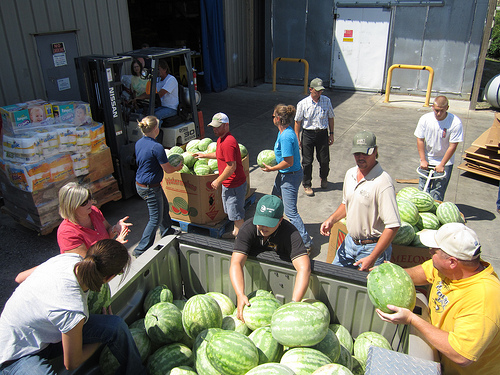In McLean, a community tucked inside Fairfax County, not everyone can access the food they need for good health. I interviewed Julie Mendoza about her efforts to connect hungry families in McLean with fresh produce.
Julie knew that Share McLean, a food pantry that serves hungry families in the area, often lacked fresh produce. As she was walking through the McLean community garden one day, she noticed that there was an abundance of fresh fruits and vegetables. She decided she would try to facilitate a relationship between the garden and Share McLean, calling it The Gardeners’ Share of McLean.

Young gardeners at St. Luke’s United Methodist Church grow food for The Gardener’s Share.
Read more »
This week, USDA and other federal departments and agencies are recognizing the huge success of the 4th annual Feds Feed Families Food Drive. USDA employees, farmers, and friends raised a total of 2.77 million pounds of food this summer! The U.S. Forest Service was a big part of this effort and the stories below captures a snapshot of how several different Forest Service offices helped fill the shelves of food banks and food pantries in their communities.
In Duluth, Minnesota, the Superior National Forest Supervisor’s Office set a goal of 2,500 pounds for the food drive. As an incentive to encourage their team, Forest Supervisor Brenda Halter and Deputy Supervisor Tim Dabney promised they would wear Smokey Bear and Woodsy Owl costumes and greet people in Duluth’s Canal Park if they reached their goal. The staff pulled together and donated 4,500 pounds of food to Second Harvest Northern Lakes Food Bank. With the goal met and far exceeded, the Forest Supervisor and Deputy Supervisor put on the Smokey Bear and Woodsy Owl costumes! Read more »

Volunteers unloading the gleaned watermelons at a food bank in Missouri.
What do the National Resource Conservation Service , Farm Service Agency, Soil and Water Conservation District (SWCD), and 16 tons of watermelons have in common? These USDA agencies have joined together in Southeastern Missouri to donate literally tons of watermelon to the food banks in Sikeston and Cape Girardeau, Missouri. This massive donation is the result of gleaning, which is the act of collecting excess foods from farmers markets, farms, stores, restaurants, gardens and elsewhere and donating that food to those in need. Read more »

Reece Latron uses a tractor to carry baskets of greens harvested from Amy's Organic Garden in Charles City, VA. While the certification system is rigorous to ensure integrity of the USDA organic label, thousands of producers and handlers continue to invest in these activities to market their products as organic. USDA Photos by Lance Cheung
The USDA organic label is backed by a certification system that verifies farmers or handling facilities located anywhere in the world comply with the USDA Organic Regulations. Certification entails five steps: Read more »

Workers hold a net full of tilapia at a fish farm in Pakistan. The fish are part of the American Soybean Association’s (ASA) World Initiative for Soy in Human Health (WISHH) program called “FEEDing Pakistan.” The Foreign Agricultural Service (FAS) helped fund the program, which aims to enhance the country’s growing aquaculture sector through trial fish feeding using high–protein, floating fish feed produced from U.S. soybean meal. (Courtesy World Initiative for Soy in Human Health)
An innovative Foreign Agricultural Service (FAS)-funded program in Pakistan is not only improving local diets, but is creating jobs, training workers and helping create a thriving aquaculture industry with U.S. soy. Read more »

Fresh broccoli in bins at the Orange County Food Bank. With a Federal-State Marketing Improvement program grant, the California Association of Food Banks was able to dramatically expand its Farm to Family program and bring more nutrient-dense foods to area food banks. Photo courtesy Ron Ploof
Sometimes it can take a while to turn a good idea into a successful venture. At USDA, we understand the value of research, and by providing resources to get things started at the local level, we often see amazing results that have positive impact for farmers, agribusinesses and consumers across the country. Read more »





